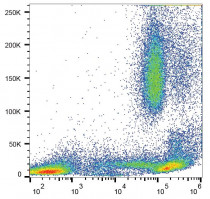ARG62851
anti-CD44 antibody [MEM-85]
anti-CD44 antibody [MEM-85] for ELISA,Flow cytometry,Immunoprecipitation,Western blot and Human
Cancer antibody; Developmental Biology antibody; Immune System antibody; Chondrogenesis Study antibody
Overview
| Product Description | Mouse Monoclonal antibody [MEM-85] recognizes CD44 |
|---|---|
| Tested Reactivity | Hu |
| Tested Application | ELISA, FACS, IP, WB |
| Specificity | The clone MEM-85 reacts with both cell surface-expressed and soluble form of CD44 antigen (Phagocyte glycoprotein 1), a 80-95 kDa transmembrane glycoprotein (hyaladherin family) present on the most of cells and tissues (leukocytes, endothelial cells, mesenchymal cells, etc.); it is negative on platelets and hepatocytes. HLDA IV; WS Code NL 706 HLDA VI; WS Code AS Ref.15 |
| Host | Mouse |
| Clonality | Monoclonal |
| Clone | MEM-85 |
| Isotype | IgG2b |
| Target Name | CD44 |
| Immunogen | Leukocytes of a patient suffering from LGL Type Leukaemia. |
| Conjugation | Un-conjugated |
| Alternate Names | MDU2; MDU3; GP90 lymphocyte homing/adhesion receptor; Hermes antigen; Extracellular matrix receptor III; PGP-I; Epican; CDW44; Phagocytic glycoprotein 1; Pgp1; HUTCH-I; MC56; Hyaluronate receptor; CD antigen CD44; Heparan sulfate proteoglycan; CD44 antigen; LHR; IN; HCELL; Phagocytic glycoprotein I; PGP-1; CSPG8; MIC4; ECMR-III; CDw44 |
Application Instructions
| Application Suggestion |
|
||||||||||
|---|---|---|---|---|---|---|---|---|---|---|---|
| Application Note | WB: 60 min on vertical incubator. Sample preparation: Resuspend approx. 50 mil. cells in 1 ml cold Lysis buffer (1% laurylmaltoside in 20 mM Tris/Cl, 100 mM NaCl pH 8.2, 50 mM NaF including Protease inhibitor Cocktail). Incubate 60 min on ice. Centrifuge to remove cell debris. Mix lysate with non-reducing SDS-PAGE sample buffer. Application note: Non-reducing condition. SDS-PAGE (6% separating gel). * The dilutions indicate recommended starting dilutions and the optimal dilutions or concentrations should be determined by the scientist. |
||||||||||
| Positive Control | WB: Kg-1a human leukemia cell lysate. |
Properties
| Form | Liquid |
|---|---|
| Purification | Purified from ascites by protein-A affinity chromatography. |
| Purity | > 95% (by SDS-PAGE) |
| Buffer | PBS (pH 7.4) and 15 mM Sodium azide |
| Preservative | 15 mM Sodium azide |
| Concentration | 1 mg/ml |
| Storage Instruction | For continuous use, store undiluted antibody at 2-8°C for up to a week. For long-term storage, aliquot and store at -20°C or below. Storage in frost free freezers is not recommended. Avoid repeated freeze/thaw cycles. Suggest spin the vial prior to opening. The antibody solution should be gently mixed before use. |
| Note | For laboratory research only, not for drug, diagnostic or other use. |
Bioinformation
| Database Links | |
|---|---|
| Gene Symbol | CD44 |
| Gene Full Name | CD44 molecule (Indian blood group) |
| Background | CD44 is a transmembrane glycoprotein expressed on the surface of most cells, which serves as a receptor for hyaluronan. CD44 mediates angiogenesis, cell adhesion, proliferation and migration, it is thus important for lymphocyte activation, recirculation and homing, it can thus serve e.g. as a modulator of macrophage recruitment in response to pathogen. Although CD44 functions are essential for physiological activities of normal cells, elevated CD44 expression correlates with poor prognosis in many carcinomas, facilitating tumour growth and metastasis, antiapoptosis and directional motility of cancer cells. |
| Function | Receptor for hyaluronic acid (HA). Mediates cell-cell and cell-matrix interactions through its affinity for HA, and possibly also through its affinity for other ligands such as osteopontin, collagens, and matrix metalloproteinases (MMPs). Adhesion with HA plays an important role in cell migration, tumor growth and progression. In cancer cells, may play an important role in invadopodia formation. Also involved in lymphocyte activation, recirculation and homing, and in hematopoiesis. Altered expression or dysfunction causes numerous pathogenic phenotypes. Great protein heterogeneity due to numerous alternative splicing and post-translational modification events. [UniProt] |
| Research Area | Cancer antibody; Developmental Biology antibody; Immune System antibody; Chondrogenesis Study antibody |
| Calculated MW | 82 kDa |
| PTM | Proteolytically cleaved in the extracellular matrix by specific proteinases (possibly MMPs) in several cell lines and tumors. N- and O-glycosylated. O-glycosylation contains more-or-less-sulfated chondroitin sulfate glycans, whose number may affect the accessibility of specific proteinases to their cleavage site(s). It is uncertain if O-glycosylation occurs on Thr-637 or Thr-638. Phosphorylated; activation of PKC results in the dephosphorylation of Ser-706 (constitutive phosphorylation site), and the phosphorylation of Ser-672. |
Images (1) Click the Picture to Zoom In
Clone References








